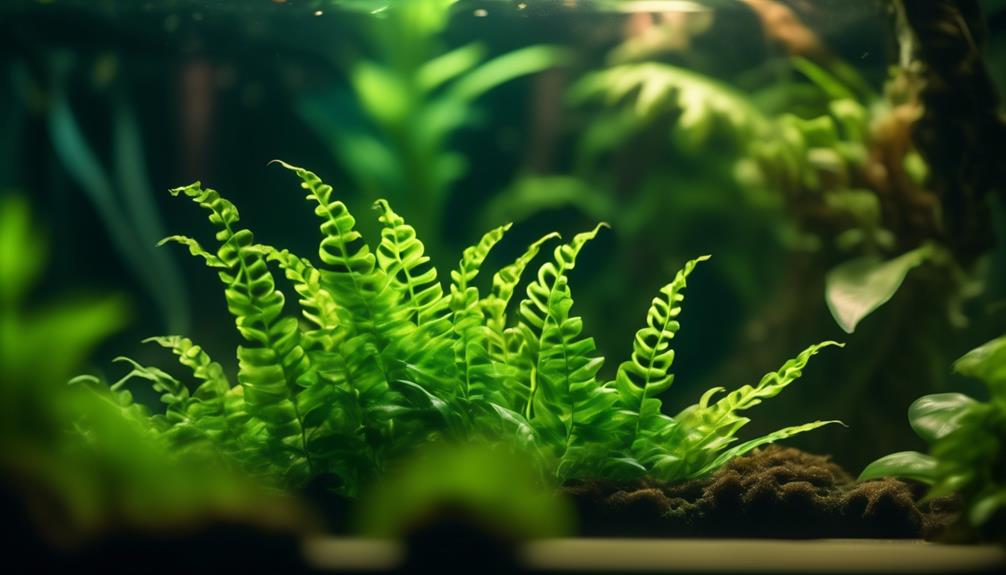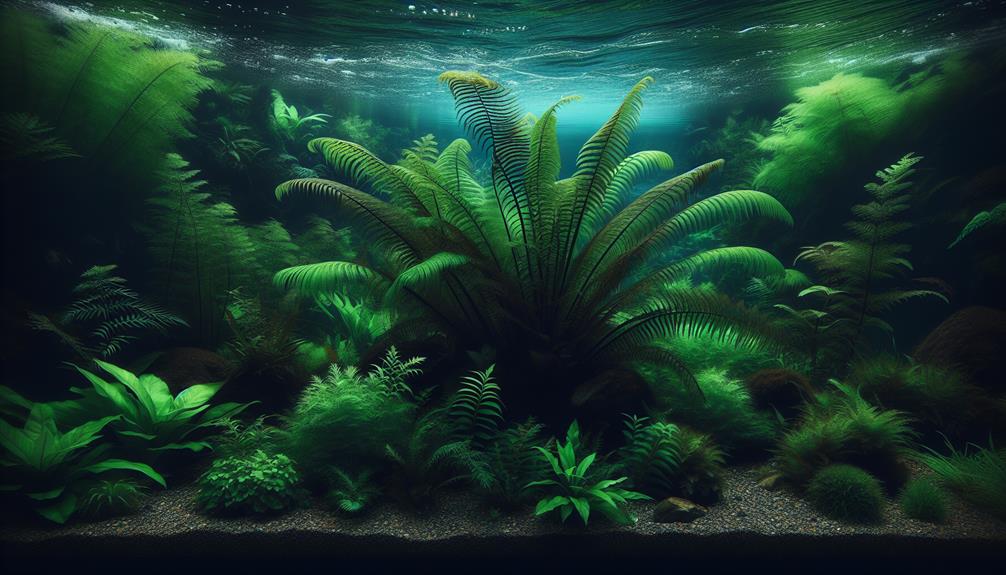Aquatic enthusiasts are constantly seeking new ways to enhance the beauty and functionality of their underwater ecosystems.
One plant that consistently rises to the top as a must-have for any aquarium is the versatile Java Fern. This unassuming yet remarkable plant offers a range of benefits that make it an indispensable addition to any tank.
From its adaptability to different lighting conditions and water environments to its ability to withstand rough play from tank inhabitants, the Java Fern has proven itself to be a resilient and aesthetically pleasing choice.
But that's just scratching the surface.
So, if you're looking to take your aquatic environment to the next level, join us as we explore the wonders of the Java Fern and uncover why it has become a staple for aquatic enthusiasts worldwide.
Key Takeaways
- Java Fern is a versatile plant that can adapt to various lighting conditions and water environments.
- When planting Java Fern, it is important to avoid burying the rhizome to prevent rotting.
- Moderate lighting is ideal for Java Fern, as high-intensity light can cause damage.
- Java Fern can reproduce through rhizome division, leaf detachment, and plantlet growth, making it a great choice for setting up new tanks.
Characteristics and Growth of Java Fern
Java Fern, a widely used plant in the world of planted aquariums, possesses unique characteristics and displays a slow growth rate, making it a must-have for aquatic enthusiasts.
This plant has a distinctive leaf structure and can tolerate various lighting conditions, making it adaptable to different water environments.
When planting Java Fern, it can be simply dropped into the water to start growing or attached to objects in the tank. However, it is important to avoid burying the rhizome to prevent rotting. Additionally, Java Fern is suitable for bare bottom tanks.
Common mistakes to avoid when growing Java Fern include planting it too deep, exposing it to high-intensity light, and not providing enough lighting.
Planting Java Fern
When planting Java Fern, it is important to consider the appropriate methods and techniques to ensure successful growth in an aquatic environment. Here are some key points to keep in mind:
- Java Fern can be simply dropped into the water to start growing or attached to objects in the tank or buried in gravel. Super glue gel can be used to attach it to décor.
- Avoid burying the rhizome of the plant to prevent rotting. The rhizome should be exposed and not covered by substrate.
- Java Fern is suitable for bare bottom tanks, where it can be attached to rocks or driftwood.
- Common mistakes when planting Java Fern include burying the rhizome, using too much light intensity, and not providing enough water flow to prevent stagnant conditions.
Lighting Requirements for Java Fern

To ensure optimal growth and health of Java Fern in an aquatic environment, it is crucial to understand and meet its specific lighting requirements. Java Fern is known for its low light tolerance, allowing it to thrive in various lighting conditions. However, it does best with a lighting spectrum of around 6700k, which mimics natural sunlight and promotes healthy growth. High-intensity light can actually cause damage to the plant, so it is important to provide moderate lighting for Java Fern. Interestingly, Java Fern can survive for weeks without any light, making it a versatile plant for aquarium enthusiasts. Here is a table summarizing the lighting requirements for Java Fern:
| Lighting Spectrum | Light Intensity | Light Duration |
|---|---|---|
| 6700k | Moderate | 8-10 hours |
Reproduction of Java Fern
The reproductive process of Java Fern involves the formation of new plants at the edges of its leaves. This unique method of propagation makes it a versatile and desirable plant for aquarium enthusiasts.
To propagate Java Fern, several techniques can be employed:
- Rhizome division: The mature plant can be carefully divided into smaller sections, ensuring that each section has a portion of the rhizome and several leaves. These sections can then be planted in new tanks to establish new plants.
- Leaf detachment: Leaves that are starting to die can be detached from the plant and floated in the tank. Over time, these detached leaves will produce new plantlets that can be separated and planted in a new tank.
- Plantlet growth: When the plant starts to die, it often produces new plantlets at the base of its leaves. These plantlets can be carefully removed and planted in a new tank to establish new plants.
- Tank setup: Java Fern is an excellent plant for setting up new tanks. Its ability to reproduce easily and quickly makes it an ideal choice for creating lush and vibrant aquatic environments.
Benefits and Compatibility of Java Fern

With its ability to create a lush and vibrant aquatic environment, Java Fern offers numerous benefits and is compatible with a variety of aquarium setups. This versatile plant is ideal for creating a natural underwater landscape, providing a jungle-like environment for fish to swim in. Its slow growth rate allows for natural aquarium decoration, enhancing the aesthetic appeal of the tank.
Additionally, Java Fern is not preferred by most fish, including plant eaters, making it a durable and long-lasting option. The thick and rugged leaves of Java Fern can withstand rough play, ensuring the well-being of both the plant and the aquarium inhabitants.
Whether it is attached to objects in the tank or planted in gravel, Java Fern thrives in various water environments, making it suitable for a wide range of aquarium setups. By incorporating Java Fern into your aquarium, you can enhance the health and well-being of your aquatic creatures while creating a visually stunning underwater landscape.
Frequently Asked Questions
Can Java Fern Be Grown Emersed (Above Water)?
Java Fern can be grown emersed (above water) with benefits including improved nutrient uptake, reduced risk of algae growth, and increased CO2 availability. This method is suitable for propagating new plants and setting up new tanks.
How Long Does It Take for Java Fern to Reach Its Full Size?
The growth rate of Java Fern can vary depending on various factors such as lighting, water quality, and nutrient availability. Generally, it takes several months to a year for Java Fern to reach its full size.
Can Java Fern Be Used in a Saltwater Aquarium?
Java Fern is not suitable for saltwater aquariums as it is a freshwater plant. However, there are alternative aquatic plants available that are compatible with saltwater tanks, such as various species of seagrasses and marine macroalgae.
Can Java Fern Be Grown in a Pond or Outdoor Water Feature?
Growing Java Fern in ponds or outdoor water features is possible. It can be attached to rocks or driftwood and placed in the water. Ensure it receives enough light and nutrients, and protect it from extreme temperatures.
Does Java Fern Require Any Special Fertilizers or Supplements for Optimal Growth?
Java Fern does not require any special fertilizers or supplements for optimal growth. It can extract nutrients from the water and substrate. However, adding liquid fertilizers or root tabs can promote healthier and faster growth.
Conclusion
In conclusion, the Java Fern proves to be an indispensable addition to any aquatic environment. Its slow growth rate, unique leaf structure, and adaptability to various lighting and water conditions make it a must-have for planted aquariums.
With its easy planting and maintenance, the Java Fern offers endless possibilities for aquarium decoration and propagation. Its benefits extend beyond aesthetics, providing a jungle-like environment for fish to explore and play in.
Embrace the versatility of the Java Fern and enhance the natural beauty of your aquatic world.

